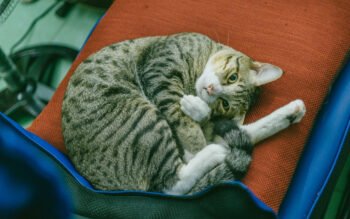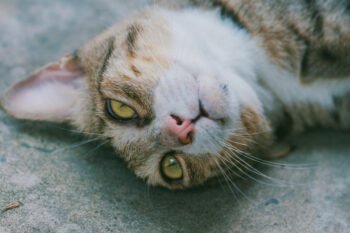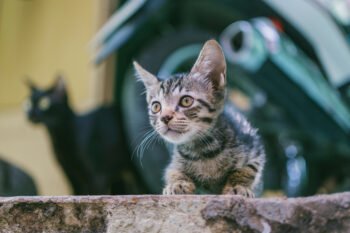Does your cat eat a lot yet lose weight? Do you find it chasing its tail around and around? Feline hyperthyroidism may be to blame. It’s not uncommon for cats older than seven years to develop the disease, which occurs when an enlarged thyroid begins to secrete excess hormones. Veterinarians don’t know what causes hyperthyroidism, but it’s fully curable if diagnosed and treated early.
Early Detection
“A routine examination by a veterinarian may pick up on the disease before owners notice any symptoms, and will allow for early treatment interventions,” says Rance Sellon, DVM, and associate professor of small animal medicine at Washington State University in Pullman, Washington. “The vet will pick up things like changes in heart rate, heart murmurs, enlarged thyroid gland — things that owners can’t see. That’s why it’s so important for middle-age to older cats to go to the vet at least once if not twice a year for general health purposes.”
Clinical Symptoms
Even the most vet-conscientious pet owners, though, may notice changes in their feline friends before their veterinarians do. Dr. Sellon says that cats with hyperthyroidism can manifest the following symptoms:
- Vomiting
- Diarrhea
- Weight loss that often occurs in face of normal or increased appetite
- Increased appetite
- Excess water consumption and urination
- Changes in behavior (e.g., couch potato cats become quite active, or active cats exhibit a change in time of activity — suddenly beginning to play all night, every night)
- Excessive meowing
- Lethargy (in only a small proportion of cats with hyperthyroidism)
- Changes in skin and hair
Testing
A simple blood test will detect the presence of feline hyperthyroidism. Your veterinarian will draw a few milliliters of blood, and test it for serum thyroid hormone concentration, or T4 level. “Your cat will object more to being restrained than to being stuck with a needle,” says Dr. Sellon. Test results will often be back in less than 48 hours.
Treatment Options
The three most common treatments for feline hyperthyroidism are medication, thyroidectomy and radioactive iodine therapy. The medication — methimazole — can be administered orally or topically, and controls but does not cure the disease. In most cases, your pet will need to take the drug every day for the rest of its life.
Thyroidectomy, the surgical removal of one or both halves of the thyroid gland, is curative, but carries with it general anesthesia risks, which are more pronounced in cats with underlying heart conditions. Your cat can live comfortably, though, without its thyroid. “Sometimes a cat will need hormone supplementation, but the impact on the animal is usually quite small,” says Dr. Sellon. “The skill of the surgeon is, of course, important. The doctor needs to take care to preserve the parathyroid gland, or the cat can develop severe problems with low calcium.” If only one half of the gland is removed, the disease can reappear in the other half.
With radioactive iodine therapy, the cat is given a subcutaneous injection of radioactive iodine. It is then kept in isolation until radioactive levels return to safe levels (the number of days differs from state to state). “This is a very effective treatment, but is limited in its availability,” says Dr. Sellon. “Usually only one injection is required, and it resolves all signs of the disease.”
Other Considerations
As a first step, many veterinarians will recommend treating a cat with methamizole. Hyperthyroidism can mask kidney disease, and it can also help maintain kidney function for cats with both conditions. Curing hyperthyroidism once and for all with the other two procedures, then, could potentially worsen kidney function in cats with latent renal problems. “If the initial drug treatment leads to decreased kidney function,” explains Dr. Sellon, “your veterinarian can find a dose of methamizole that controls the symptoms of hyperthyroidsim, but still maintains the kidneys.”
The Importance of Treatment
If left untreated, feline hyperthyroidism can shorten a cat’s lifespan, resulting in congestive heart failure, ocular disease, and hypertension. If treated appropriately, your furry friend will live a long and healthy life. That’s something worth meowing over.







